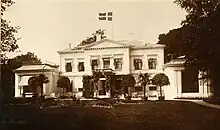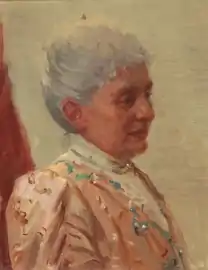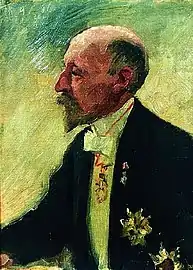Leaving the Table
Leaving the Table (Danish: Man rejser sig fra bordet), also known as Dinner Party at the Morescos' (Danish: Aftenselskab hos familien Moresco), is a 1906 oil-on-canvas group portrait painting by Laurits Tuxen depicting a dinner party in Danish businessman Jacob Heinrich Moresco's home north of Copenhagen. The painting was a gift to Moresco on the occasion of the 50th anniversary of his firm. Many of the 45 people seen in the painting are well-known businessmen, politicians or other peers of the time.
| Leaving the table | |
|---|---|
| Danish: Man rejser sig fra bordet | |
.jpg.webp) | |
| Artist | Laurits Tuxen |
| Year | 1906 |
| Medium | oil on canvas |
| Dimensions | 142 cm × 212 cm (56 in × 83 in) |
Background

On 16 April 1856, Jacob Heinrich Moresco opened a store with women's clothing and fashion accessories at Amagertorv 13. His firm would later develop into the first large-scale industrial manufacturer of women's clothing in Denmark. Moresco is one of the businessmen depicted on Peder Severin Krøyer's monumental 1895 group portrait painting From Copenhagen Stock Exchange in Børsen.[1]
Creation
Leaving the Table was commissioned from Lauritz Tuxen as a gift to Moresco on the occasion of the 50th anniversary of his company on 16 April 1906. It was painted on the basis of a black-and-white photograph taken at a dinner party some time before the anniversary. The dinner party took place in Moresco's home, Villa Adelaïde, at Ordrupvej 119, in Ordrup. The house was named after Moresco's mother. The property was acquired by Gentofte Municipality in 1943 and the building was subsequently demolished to make way for Ordrup Park.[2]
Provenance
Moresco died in October 1906. just a few months after the anniversary.[1] The painting remained in the Moresco family for the next more than 70 years. On 23 April 1991, it was sold at a Bruun Rasmussen auction to Ole Abildgaard for DKK 480,000, then a price record for a Tuxen painting.[3] The Danish Commission of Export of Cultural Assets (Kulturværdiudvalget) had the same year issued an export ban under the Act on Protection of Cultural Assets in Denmark (No. 332 of 4 July 1876).[4] On 15 November 1995, it was sold at another auction, this time at Kunsthallen, for DKK 250.000.[4] The buyer was by Kunstnyt.dk reported to be the Kolding-based businessman Christian Houe.[3] He later moved it out of the country illegally and in 1997 sold it at a Sotheby's New York auction for US§ 84,000 (the equivalent of DKK 548,000).[3] The buyer was New York-based art collector John Oden. On 22 October 2010, TV2 broadcastet a programme about the faith of the painting. In an interview with Oden, he stated that he had no intention of parting with the painting.[4]
People
Related works
Tuxen painted a number of portrait studies of some of the people seen in the picture, including Enevold Sørensen (Kolding City Hall, acquired in 1920), Charles Shaw (Skagens Museum), Morescos, Marie Warelius, Emil Hjort, Johannes Werner and N. P.Jensen.
 Marie Warelius
Marie Warelius Emil Hjort
Emil Hjort Enevold Sørensen
Enevold Sørensen
References
- "Jacob Heinrich" (in Danish). Dansk Biografisk Leksikon. Retrieved 6 February 2019.
- "MG-65 Jacob Heinrich Moresco". beitolam.com (in Danish). Retrieved 6 February 2019.
- Madsen, Preben Juul. "Sandheden om et ulovligt udført maleri af Laurits Tuxen" (PDF). kunstnyt.dk (in Danish). Retrieved 11 April 2022.
- "Ulovligt udført". kulturnyt.dk (in Danish). Retrieved 11 April 2022.
- "Sophus Bauditz" (in Danish). Dansk Biografisk Leksikon. Retrieved 9 April 2022.
- "William Bloch". Dansk Biografisk Leksikon (in Danish). Retrieved 9 April 2022.
- "Chr. Hasselbalch" (in Danish). Dansk Biografisk Leksikon. Retrieved 9 February 2017.
- "Holger Petersen" (in Danish). Dansk Biografisk Leksikon. Retrieved 9 April 2022.
- "Enevold Sørensen" (in Danish). Dansk Biografisk Leksikon. Retrieved 9 April 2022.
- "Edgar Collin" (in Danish). Dansk Biografisk Leksikon. Retrieved 9 April 2022.
